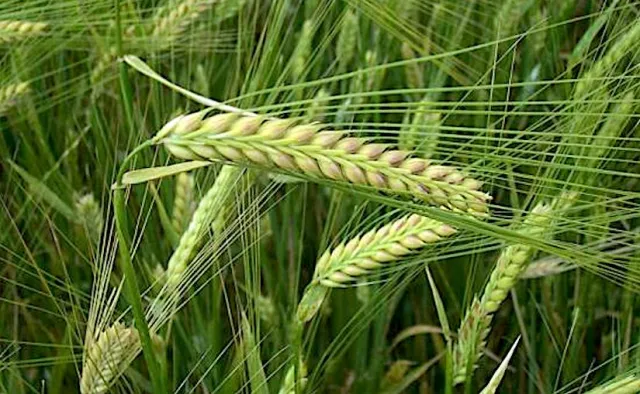Share this Article
Hordeum vulgare, commonly known as barley, is a significant cereal crop in Nepal, particularly in the high-altitude regions. It is the fifth most cultivated cereal in the country, following rice, maize, wheat, and finger millet. Barley is primarily grown in the mid-hill and mountainous areas, with a total cultivated area of approximately 25,817 hectares and a production of about 23,224 metric tons, yielding an average of 900 kg per hectare .
In Nepal, barley is cultivated in two main forms: hulled and naked barley. Naked barley (Hordeum vulgare var. nudum), locally known as "Uwa" or "Mudule Jau," is particularly valued for its loose husk, making it easier to process and consume. This variety is well-suited for the high-altitude regions, thriving in marginal lands with a short growing season and minimal external inputs .
Cultivation and Distribution
Barley is cultivated across various ecological zones in Nepal, from the Terai plains up to elevations of 4,000 meters in the Himalayan foothills. It thrives in rainfed conditions, making it a resilient crop for farmers in marginal and remote areas. The mid-western region of Nepal has the highest concentration of barley cultivation .
Varieties and Landraces
Nepal is home to a rich diversity of barley landraces, including both hulled and naked types. Naked barley (Hordeum vulgare var. nudum) is particularly valued for its minimal husk, making it easier to process and consume. These landraces are adapted to the high-altitude environments, typically above 2,500 meters, and are known for their resilience and nutritional benefits .
Nutritional and Cultural Significance
Barley, particularly naked barley (Hordeum vulgare var. nudum), is rich in soluble β-glucans, which help lower cholesterol levels and regulate blood glucose. In Nepal, barley is traditionally consumed as "Satu" (roasted barley flour), flatbreads, dumplings, and "Thukpa" (noodle soup). It is also mixed with flours of other crops like wheat, buckwheat, and finger millet.
Climate Resilience and Adaptability
Barley is well-suited to Nepal's diverse climatic conditions, thriving in both the Terai plains and the high-altitude regions up to 4,000 meters. Its adaptability to various elevations and climates makes it a reliable crop for farmers in marginal and remote areas. Additionally, barley's tolerance to drought and low-input conditions enhances its resilience, ensuring stable yields even in challenging environments.
Nutritional and Health Benefits
Barley is rich in soluble β-glucans, which have been shown to lower cholesterol levels and regulate blood glucose, contributing to cardiovascular health and diabetes management. Its low glycemic index and high fiber content aid in weight management and digestive health. Regular consumption of barley can also improve gut health and potentially reduce the risk of certain cancers.
Cultural and Culinary Significance
In Nepal, barley is integral to traditional diets, especially in the highlands. It is used to prepare various foods such as "Satu" (roasted barley flour), flatbreads, dumplings, and "Thukpa" (noodle soup). Barley is also utilized in the production of traditional fermented beverages like "Chhyang" and distilled liquors, which are important in cultural and religious ceremonies.
Economic and Agricultural Value
Barley cultivation supports the livelihoods of farmers in Nepal's mountainous regions. The crop's ability to grow in marginal lands with minimal inputs makes it an essential component of sustainable agriculture. Barley straw is used as animal feed, and the grains are sold or traded, providing economic benefits to rural communities.
Contribution to Food Security
In areas where food insecurity is prevalent, barley serves as a reliable and nutritious food source. Its cultivation in high-altitude regions contributes to food security by providing a stable supply of grains that can withstand adverse climatic conditions. The promotion of barley cultivation can play a crucial role in addressing food security challenges in Nepal's mountainous regions.
Hordeum vulgare (Barley) is a versatile crop with numerous applications in Nepal, encompassing food, beverages, livestock feed, and traditional practices. Below is a detailed overview of its various uses:
Food and Culinary Uses
- Satu: A traditional preparation made from roasted barley flour, commonly consumed in the highlands of Nepal. It can be eaten as is or used in various dishes.
- Flatbreads and Dumplings: Barley flour is used to make staple foods like flatbreads and dumplings, often combined with flours from other grains such as buckwheat and finger millet.
- Thukpa: A noodle soup where barley flour is used to make the noodles, providing a hearty meal.
Traditional Beverages
- Chhaang: A semi-fermented alcoholic beverage made from barley, millet, or rice. In Nepal, it's prepared by passing hot water through fermenting barley, then served in a large pot and drunk through a wooden straw.
- Jand: A traditional alcoholic drink obtained by leaching out the extract from fermented barley mash. It's consumed in large mugs and is a part of cultural practices.
Livestock Feed and Forage
- Barley Straw: Used as animal feed, either directly fed to animals or used for silage.
- Green Leaves: Barley plants' green leaves serve as green forage in areas where other forage crops cannot be grown.
Brewing and Distillation
- Malt Production: Barley is malted to produce enzymes essential for brewing. Studies have shown that malt prepared from naked barley varieties, such as Solu Uwa, has high enzyme activity suitable for brewing.
- Whisky Production: Malted barley is used in the production of whisky, with research indicating that using mold bran as an enzyme source can enhance the brewing process.
Conclusion
Barley (Hordeum vulgare) remains a cornerstone of Nepal's agricultural landscape, especially in the high-altitude regions where it supports food security, cultural practices, and sustainable livelihoods. Continued research and conservation of barley landraces, along with the promotion of high-yielding varieties, are essential for enhancing its role in Nepal's agricultural systems.
Categories:
Medicinal Plants of Nepal
Tags:
HimalayanGrain







